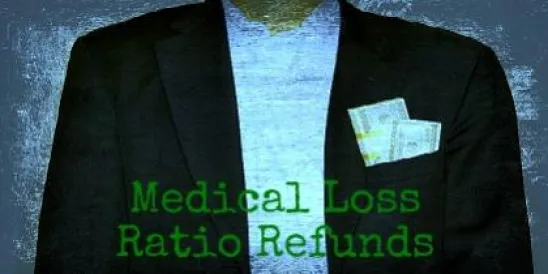If you are an employer that sponsors a fully insured medical plan option for your employees, and you had that fully insured medical plan option in place for the 2011 calendar year, you may be eligible for a Medical Loss Ratio rebate.
Are you an employer that sponsors a fully insured medical plan option for your employees? Did you have that fully insured medical plan option in place for the 2011 calendar year? If so, you may be eligible for a Medical Loss Ratio (MLR) rebate.
The Patient Protection and Affordable Care Act (Affordable Care Act), enacted on March 23, 2010, amended the Public Health Service Act (PHSA) by adding Section 2718. This new section requires that health insurance issuers (Issuers) publicly report on major categories of spending of policyholder premium dollars, such as clinical services provided to enrollees and activities that will improve health care quality. In addition, the law establishes MLR standards for Issuers. The MLR is the percentage of dollars used by the Issuer to pay medical claims costs versus administrative fees, expenses and profits. The MLR for a large group is 85 percent, while the MLR for a small group or individual policy is 80 percent. Special MLR rules apply to “mini-med” and expatriate policies. If an Issuer does not meet the MLR standard, it is required to provide rebates to policyholders.
The Department of Health and Human Services (HHS) has issued regulations interpreting and implementing the requirements of section 2718 of the PHSA, however the regulations do not give specific instructions to policyholders who are group health plans covered by the Employee Retirement Income Security Act of 1974 (ERISA), or who are the sponsors of such plans, regarding their responsibilities under ERISA. To the extent that the MLR rebate is a plan asset, it is subject to ERISA’s fiduciary restrictions on the treatment of plan assets. Generally, ERISA requires that plan assets not inure to the benefit of any employer and be held for the exclusive purpose of providing benefits to plan participants and beneficiaries and defraying reasonable expenses of plan administration. The U.S. Department of Labor (DOL) released Technical Release No. 2011-04 to provide plan sponsors guidance in this area. Whether or not your MLR rebate is a plan asset, and whether you as the plan sponsor may keep all or part of the MLR rebate, is very fact specific. How the MLR rebate is refunded to your plan participants may result in taxable income to those participants. You do, however, have options.
The Issuer is required, in certain circumstances, to send an MLR rebate notice to both the employer and employees. Therefore, employers should be prepared to respond to questions from employees who receive the notice. Thus, this MLR notice may have some employees expecting that they will receive checks from the Issuer, so employers may want to issue their own communication.
If all or a portion of the MLR rebate constitute plan assets, DOL guidance indicates that the rebate must be used within three months of receipt or must be placed into trust. If you have not been contacted by your Issuer, you may wish to reach out to your Issuer to confirm that you are not eligible for a rebate. (You should have received notice if your insurance policy was not eligible for an MLR rebate for 2011). 2011 MLR rebates were due by August 1, 2012.



 />i
/>i

